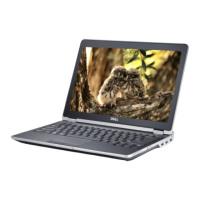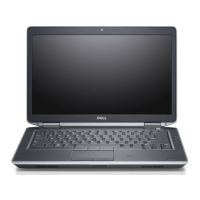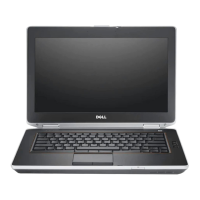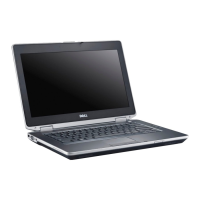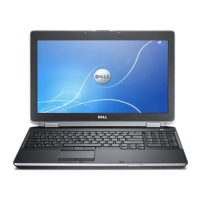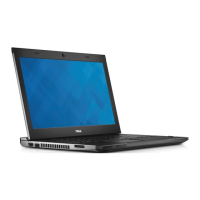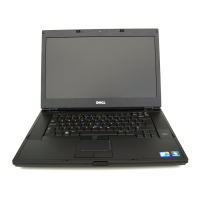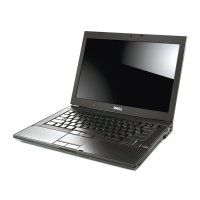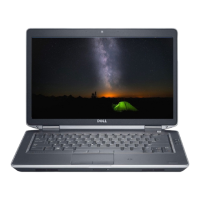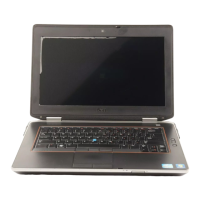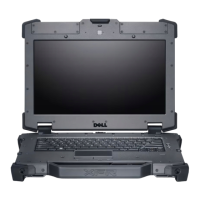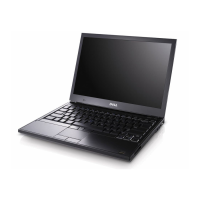Do you have a question about the Dell Latitude E6230 and is the answer not in the manual?
Guidelines and steps for safe preparation before performing computer maintenance.
Procedure for safely shutting down the computer before servicing.
Steps to reconnect devices and power on the computer post-maintenance.
List of essential tools for component removal and installation.
Instructions for removing and installing the SD card.
Instructions for removing and installing the ExpressCard.
Steps for removing and installing the main battery.
Instructions for removing and installing the SIM card.
Steps for removing and installing the computer's base cover.
Instructions for removing and installing the Bluetooth module.
Steps for removing and installing the computer's hard drive.
Steps for removing and installing memory modules (RAM).
Steps for removing and installing the palmrest assembly.
Steps for removing and installing the computer's keyboard.
Instructions for removing and installing the Wireless Local Access Network card.
Steps for removing and installing the heat-sink fan.
Steps for removing and installing the heat-sink module.
Steps for removing and installing the computer's speakers.
Steps for removing and installing the computer's chassis base.
Instructions for removing and installing the Hall sensor.
Steps for removing and installing the coin-cell battery.
Steps for removing and installing the computer's system board.
Steps for removing and installing the power-connector port.
Instructions for removing and installing the ExpressCard cage.
Instructions for removing and installing the WiFi-switch board.
Instructions for removing and installing the smart card cage.
Steps for removing and installing the display bezel.
Steps for removing and installing the display panel.
Steps for removing and installing the entire display assembly.
Steps for removing and installing the camera module.
Instructions for removing and installing the LVDS and camera cable.
Information about the computer's docking port for expansion.
Bypassing setup to boot directly to a specific device.
Table listing keys used for navigating System Setup options.
Overview of general system setup options and their descriptions.
Options for configuring ports, drives, and SATA operations.
Options for managing USB, keyboard illumination, and miscellaneous devices.
Options for system security, passwords, and video settings.
Settings for processor performance and setup access.
Options for managing power behavior, wake-up, and battery.
Settings affecting the Power-On Self Test behavior and boot process.
Settings for virtualization, wireless devices, maintenance, and system logs.
Recommended procedure for updating the computer's BIOS.
Information on creating and managing system and setup passwords.
Procedure to delete or change existing system and setup passwords.
Procedure for running comprehensive hardware diagnostics using ePSA.
Explanation of device status LEDs and their diagnostic meanings.
Explanation of battery status indicator lights and their meanings.
Details on chipset, processor, memory, and audio hardware.
Details on network, wireless, ports, connectors, and display hardware.
Details on keyboard, touchpad, and battery hardware specifications.
Detailed specifications for battery types and AC adapter characteristics.
Dimensions, weight, operating temperature, and humidity specifications.
Instructions on how to contact Dell for sales, technical support, or customer service.
Guidelines and steps for safe preparation before performing computer maintenance.
Procedure for safely shutting down the computer before servicing.
Steps to reconnect devices and power on the computer post-maintenance.
List of essential tools for component removal and installation.
Instructions for removing and installing the SD card.
Instructions for removing and installing the ExpressCard.
Steps for removing and installing the main battery.
Instructions for removing and installing the SIM card.
Steps for removing and installing the computer's base cover.
Instructions for removing and installing the Bluetooth module.
Steps for removing and installing the computer's hard drive.
Steps for removing and installing memory modules (RAM).
Steps for removing and installing the palmrest assembly.
Steps for removing and installing the computer's keyboard.
Instructions for removing and installing the Wireless Local Access Network card.
Steps for removing and installing the heat-sink fan.
Steps for removing and installing the heat-sink module.
Steps for removing and installing the computer's speakers.
Steps for removing and installing the computer's chassis base.
Instructions for removing and installing the Hall sensor.
Steps for removing and installing the coin-cell battery.
Steps for removing and installing the computer's system board.
Steps for removing and installing the power-connector port.
Instructions for removing and installing the ExpressCard cage.
Instructions for removing and installing the WiFi-switch board.
Instructions for removing and installing the smart card cage.
Steps for removing and installing the display bezel.
Steps for removing and installing the display panel.
Steps for removing and installing the entire display assembly.
Steps for removing and installing the camera module.
Instructions for removing and installing the LVDS and camera cable.
Information about the computer's docking port for expansion.
Bypassing setup to boot directly to a specific device.
Table listing keys used for navigating System Setup options.
Overview of general system setup options and their descriptions.
Options for configuring ports, drives, and SATA operations.
Options for managing USB, keyboard illumination, and miscellaneous devices.
Options for system security, passwords, and video settings.
Settings for processor performance and setup access.
Options for managing power behavior, wake-up, and battery.
Settings affecting the Power-On Self Test behavior and boot process.
Settings for virtualization, wireless devices, maintenance, and system logs.
Recommended procedure for updating the computer's BIOS.
Information on creating and managing system and setup passwords.
Procedure to delete or change existing system and setup passwords.
Procedure for running comprehensive hardware diagnostics using ePSA.
Explanation of device status LEDs and their diagnostic meanings.
Explanation of battery status indicator lights and their meanings.
Details on chipset, processor, memory, and audio hardware.
Details on network, wireless, ports, connectors, and display hardware.
Details on keyboard, touchpad, and battery hardware specifications.
Detailed specifications for battery types and AC adapter characteristics.
Dimensions, weight, operating temperature, and humidity specifications.
Instructions on how to contact Dell for sales, technical support, or customer service.
| Bus type | DMI |
|---|---|
| Stepping | L1 |
| Tjunction | 105 °C |
| Processor cache | 3 MB |
| Processor cores | 2 |
| System bus rate | 5 GT/s |
| Processor family | Intel® Core™ i5 |
| Processor series | Intel Core i5-3300 Mobile series |
| Processor socket | BGA 1023 |
| Processor threads | 4 |
| Processor codename | Ivy Bridge |
| Processor frequency | 2.6 GHz |
| Processor cache type | Smart Cache |
| Processor lithography | 22 nm |
| Processor manufacturer | Intel |
| Processor front side bus | - MHz |
| PCI Express slots version | 3.0 |
| Processor boost frequency | 3.3 GHz |
| Processor operating modes | 64-bit |
| ECC supported by processor | No |
| PCI Express configurations | 1x16, 2x8, 1x8+2x4 |
| Thermal Design Power (TDP) | 35 W |
| CPU multiplier (bus/core ratio) | 26 |
| Maximum number of PCI Express lanes | 16 |
| Motherboard chipset | Intel® QM77 Express |
| Memory slots | 2x SO-DIMM |
| Internal memory | 4 GB |
| Memory clock speed | 1600 MHz |
| Internal memory type | DDR3-SDRAM |
| Maximum internal memory | 8 GB |
| Memory slots (available) | 1 |
| Memory layout (slots x size) | 1 x 4 GB |
| HDD size | 2.5 \ |
| HDD speed | 7200 RPM |
| Storage media | HDD |
| Card reader integrated | Yes |
| Total storage capacity | 320 GB |
| Display diagonal | 12.5 \ |
| Display resolution | 1366 x 768 pixels |
| Native aspect ratio | 16:9 |
| On-board graphics card ID | 0x166 |
| Discrete graphics card model | Not available |
| On-board graphics card model | Intel® HD Graphics 4000 |
| On-board graphics card family | Intel® HD Graphics |
| On-board graphics card base frequency | 650 MHz |
| On-board graphics card dynamic frequency (max) | 1200 MHz |
| Audio system | - |
| Wi-Fi standards | Wi-Fi 4 (802.11n) |
| Bluetooth version | 4.0 |
| Cabling technology | 10/100/1000Base-T(X) |
| Networking features | Gigabit Ethernet |
| Ethernet LAN data rates | 10, 100, 1000 Mbit/s |
| Charging port type | DC-in jack |
| USB 2.0 ports quantity | USB 2.0 ports have a data transmission speed of 480 Mbps, and are backwards compatible with USB 1.1 ports. You can connect all kinds of peripheral devices to them. |
| eSATA/USB 3.2 Gen 1 (3.1 Gen 1) ports quantity | 0 |
| Pointing device | Touchpad |
| Operating system installed | Windows 7 Professional |
| Product color | Silver |
| Battery life (max) | - h |
| Number of battery cells | 6 |
| AC adapter power | 65 W |
| Processor code | SR0MY |
| Processor ARK ID | 64896 |
| Processor package size | 37.5 x 37.5 (rPGA988B); 31.0 x 24.0 (BGA1023) mm |
| Supported instruction sets | AVX |
| Intel Identity Protection Technology version | 1.00 |
| Sustainability certificates | EPEAT Silver, ENERGY STAR |
| Depth | 226 mm |
|---|---|
| Width | 309 mm |
| Weight | 1380 g |
| Height (rear) | 24.7 mm |
| Height (front) | 22.4 mm |
